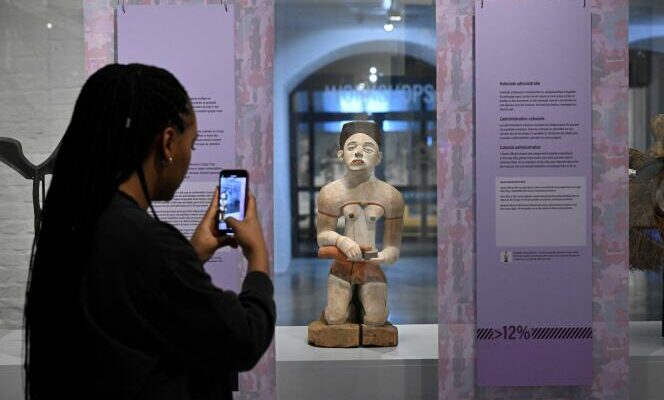Engaged in a process of restitution of objects looted in its former colony of Congo, Belgium has immersed itself in research into the provenance of its immense collections, acquired largely in a context of violence. “We want to know much better about the origin of the objects and whether we can establish that they were obtained by theft, by violence, by manipulation”explains to AFP Bart Ouvry, director of the Royal Museum for Central Africa, known as the “Africa Museum”.
An inventory of more than 80,000 cultural objects (sculptures, masks, utensils, musical instruments, etc.), mainly from the current Democratic Republic of Congo (DRC), was transmitted to the Congolese authorities in February 2022. Four months later, Belgium adopted a law to regulate the restitution of looted property between 1885 and 1960, during which the Congo was the personal property of the Belgian King Leopold II and then became a Belgian colony, until its independence.
At this stage, no request for restitution has yet been made by Kinshasa, indicates Thomas Dermine, Secretary of State in charge of the file, specifying that a mixed commission of Belgian and Congolese experts must now be formed to decide on the legitimate nature or not of the acquisition of the objects.
Objects “collected” under duress
Presented in an exhibition on this theme, “Rethinking Collections”, which opens Thursday January 18, the statue of Chief Ne Kuko is one of the symbols of this spoliation. “The Congolese diasporas took this statue as an emblem of the need for restitution”, underlines Agnès Lacaille, one of the curators of the exhibition. A Belgian trader, Alexandre Delcommune, seized it during an attack launched against the chiefs of Boma (west of the DRC), in 1878, to punish them for having introduced an increase in taxes on their trade routes.
At the time, objects were “collected” notably by soldiers, administration agents and missionaries, recalls the historian Didier Gondola, co-author of the work The Collection Factoryemphasizing the ” violence “ and the ” constraint “ accompanying these seizures.
Requests for restitution are not new: they were notably made at the end of the 1960s by the dictator Mobutu Sese Seko, after an exhibition in the United States of Congolese objects from Brussels collections. At the end of the 1970s, the museum had returned to the country – at the time Zaire – 114 objects, but of secondary quality.
“At the time of Mobutu, Europeans said: ‘We are doing you a service because we are preserving your objects. If we gave them back to you, they would end up on the international art market, be resold because the power is corrupt, or they would be damaged because you do not have the means to keep them”explains Didier Gondola. Things have changed. In Kinshasa, there is a very beautiful museum, as modern as this one, where there is still room for these objects to be reintegrated into the national heritage. This fear should therefore not serve as a justification for dragging our feet in undertaking rapid and effective restitution. »
The “deep regrets” of King Philippe
In spring 2022, before the vote on the law on restitution, a giant mask kakuungu, which was used for initiation rites of the Suku ethnic group, was loaned for a period “unlimited” at the National Museum of the DRC. It was presented by King Philippe during a visit to Kinshasa during which the Belgian sovereign expressed his “deep regrets” for the colonial period.
But beyond an object, it is sometimes an intangible cultural heritage that has been removed: this is the case for musical instruments, underlines the other curator of the exhibition, Sarah Van Beurden, in front of a xylophone manza kidnapped in 1911-1912 in the province of Bas-Uélé. “When we remove an object like this xylophone, we remove the possibility for a community to maintain cultural customs. We can return an object, but we cannot return what this community has lost, there is a void that has been created”she said, highlighting a project involving young people from the community where this xylophone comes from in order to recreate “in a new way” the music played with this instrument.
